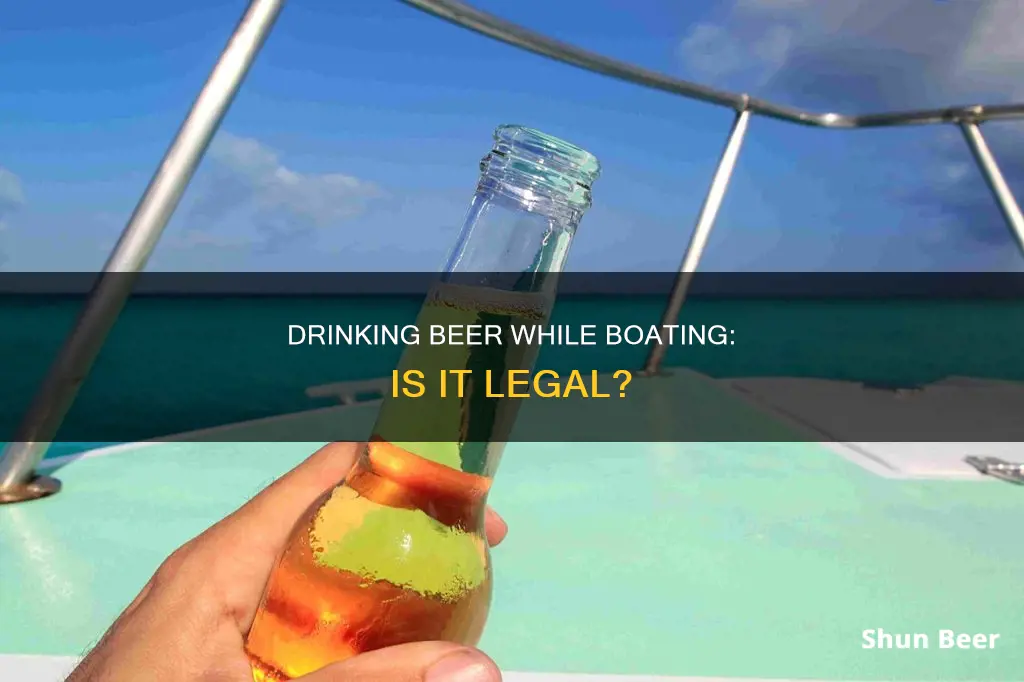
Drinking a beer while driving a boat is a fun way to spend a summer day, but it can be dangerous and even illegal. In the US, all 50 states have laws regarding alcohol consumption and boat operation, with penalties ranging from hefty fines to jail time. While drinking on a boat is not illegal, operating a boat while intoxicated is, and it is a federal offense. The legal limit for drinking and driving a boat is a blood alcohol concentration (BAC) of 0.08% g/dL, and the same is true for operating a car. However, even if your BAC is under the legal limit, you can still be charged if a law enforcement officer deems you to be impaired.
| Characteristics | Values |
|---|---|
| Legality of drinking while driving a boat | Illegal in all 50 states |
| Legal drinking limit | Blood Alcohol Concentration (BAC) of 0.08% |
| Drinking limit for underage drinkers | Zero tolerance in many states |
| Drinking rules for passengers | Allowed in most states |
| Penalties for drinking and driving a boat | Vary from state to state; may include fines, jail time, suspension of boating license, loss of driving privileges, and seizure of the boat |
| Risks of drinking and boating | Increased odds of drowning, falling overboard, and driving recklessly |
What You'll Learn
- Drinking while driving a boat is illegal in the US
- The blood alcohol limit for operating a boat is the same as for driving a car
- Drinking on a boat can be more dangerous than drinking and driving a car
- You can drink on a boat if you're not driving
- The penalties for drinking and driving a boat are similar to those for drinking and driving a car

Drinking while driving a boat is illegal in the US
The penalties for drinking and driving a boat vary from state to state but generally include hefty fines and possible jail time. For example, in Alabama, a first offense could result in a fine of up to $2,100 and/or a sentence of up to one year in jail, in addition to the suspension of the operator's certification for 90 days. Subsequent offenses carry even harsher penalties.
The dangers of operating a boat while under the influence are similar to those of driving a car, but with a few extra considerations that make it even more dangerous. Balance is crucial when operating a boat, and alcohol impairs a person's balance and coordination. Additionally, drinking affects judgment, depth perception, and reaction time, which can lead to collisions with other vessels or personal property. Alcohol also increases the risk of falling overboard and drowning, as it is a factor in a quarter of all boat-related fatalities.
It is important to note that open container laws for boats differ from those for motor vehicles. While it is illegal to operate a boat while under the influence, passengers are generally allowed to drink aboard as long as it does not hinder the safe operation of the boat. However, drinking may be discouraged on smaller boats due to the increased risk of capsizing.
Breastfeeding and Beer: Is Half a Beer Safe?
You may want to see also

The blood alcohol limit for operating a boat is the same as for driving a car
Drinking on a boat is not illegal, and with moderation, it can be a nice way to relax in the sun with friends and family. However, operating a boat while intoxicated is illegal in every US state, and the blood alcohol limit for doing so is the same as for driving a car. In the US, this limit is a blood alcohol concentration (BAC) of 0.08% g/dL. This limit applies to any boat, including canoes, kayaks, and rowboats.
The penalties for boating while intoxicated are also similar to those for driving a car under the influence. These may include the loss or suspension of a boating license, the loss of driving privileges, and possible jail time. For example, in Alabama, a first offence could result in a fine of up to $2,100 and/or a sentence of up to one year in jail, in addition to the suspension of the operator's certification for 90 days.
It's important to note that each state may have its own specific rules and regulations regarding alcohol consumption and boat operation. Additionally, certain bodies of water may have unique rules. Therefore, it's essential to familiarise yourself with the local laws and regulations before drinking on a boat.
While drinking on a boat may be legal in some places, it's crucial to prioritise safety. Boating can be hazardous, especially when an individual's faculties are impaired by alcohol. The US Coast Guard warns that people with a BAC of 0.10% or higher are ten times more likely to be killed in a boating accident than sober boat operators.
To ensure safety, it's recommended to designate a non-drinking driver before beginning a boat excursion. Additionally, passengers should drink responsibly and be mindful of the risks associated with alcohol consumption while on the water.
Beer and Army Uniforms: What's the Official Stance?
You may want to see also

Drinking on a boat can be more dangerous than drinking and driving a car
Firstly, let's look at the legal aspect. In the United States, all 50 states have laws regarding alcohol consumption and boat operation. The legal limit for drinking and driving a car is typically a blood alcohol concentration (BAC) of 0.08%, and the same limit applies to operating a boat. However, it's important to note that each state may have its own specific penalties for drinking and driving a boat, which can include loss or suspension of a boating license, mandatory enrollment in substance abuse treatment, loss of driving privileges, and even seizure and sale of the vessel.
Now, let's discuss why drinking on a boat can be more dangerous than drinking and driving a car. When operating a boat, you need to be aware of tides, currents, underwater obstacles, other boaters, people or objects in the water, and changing weather conditions. There are no clear roads or lanes on the water, so it's crucial to have your wits about you at all times. According to the American Boating Association, in 2016, there were nearly 4,500 boating accidents and over 700 deaths, with alcohol being the primary factor in 15% of these fatalities. The effects of alcohol are often enhanced by the sun and the water, leading to greater impairment.
Alcohol is a central nervous system depressant, which slows down bodily functions, lowers inhibitions, impairs decision-making, and slows reaction time and reflexes. These effects can be especially dangerous when operating a boat, increasing the risk of accidents, drowning, falling overboard, and reckless driving. Additionally, alcohol can disrupt balance, making it even harder to maintain stability on a boat.
Even if the boat is anchored, excessive alcohol consumption can still be risky. It can impair your judgment, making it more likely to make unsafe choices, and it can also impact your ability to recover from any mistakes, which can be fatal when on the water.
In conclusion, while drinking on a boat may be legal in some places, it is crucial to understand the dangers involved. The combination of alcohol, sun, and water can impair your judgment and reflexes, increasing the risk of accidents and endangering yourself and others. So, if you're planning to drink on a boat, it's important to drink in moderation, stay within the legal BAC limits, and always have a designated sober driver.
Beer and Running: Is It Safe to Run After Drinking?
You may want to see also

You can drink on a boat if you're not driving
Drinking on a boat is not illegal and can be a nice way to relax in the sun with friends and family. However, it is illegal to operate a boat while intoxicated or under the influence of any substance. In the US, the legal limit for operating a boat is the same as for driving a car—a blood alcohol level of 0.08 BAC. If you are above this limit, you can be subject to a BUI (boating while under the influence) and the penalties will be the same as a DUI. For example, in South Carolina, the law states that "convicted boaters will be subject to a minimum fine of $200 and up to 30 days imprisonment for their first offense."
If you are drinking on a boat, it is important to drink in moderation and know your limits. Do not go above the legal BAC and do not risk the safety of other boaters. It is also important to be aware of local laws and regulations, as they can vary by state and even by body of water. For example, in Canada, impaired operation of a boat is an offense under the Criminal Code of Canada, and in Kentucky, alcohol is not allowed on the water or in boats.
If you are the operator of a boat, it is your responsibility to ensure the safety of everyone on board. This includes making sure that there are enough life jackets, fire extinguishers, throwable flotation devices, and navigation lights. It is also important to be aware of your surroundings and be prepared for any emergencies that may arise.
If you are drinking on a boat, it is always a good idea to have a designated driver, just as you would if you were going to a bar in town. This person can help ensure the safety of everyone on board and make sure that everyone has a good time within the constraints of the law.
Beer and Metro North: What's Allowed?
You may want to see also

The penalties for drinking and driving a boat are similar to those for drinking and driving a car
Drinking on a boat is not illegal, and with moderation, it can be a nice way to relax in the sun with your close friends and family. However, operating a boat while intoxicated is a different story. Legally speaking, you may not drive your boat while under the influence of any substance on any body of water. The penalties for drinking and driving a boat are similar to those for drinking and driving a car.
In the United States, all 50 states have laws regarding alcohol consumption and boat operation. In many states, the laws for drinking and operating a boat are similar to those for drinking and driving a car. The legal limit for drinking and driving a car is a blood alcohol concentration (BAC) of 0.08% g/dL, and the same is true for operating a boat. This limit applies to any boat, including canoes, kayaks, and rowboats. Operating a boat under the influence of alcohol is a federal offense.
The penalties for drinking and driving a boat can include the loss or suspension of a boating license, mandatory enrollment in a substance abuse treatment program or alcohol education class, loss of driving privileges, and the seizure or impoundment of the boat. These penalties are similar to those for drinking and driving a car. For example, in Alabama, a first offense of drinking and driving a boat could result in a fine of up to $2,100 and/or a sentence of up to one year in jail, in addition to the suspension of the operator's certification for 90 days. These consequences are similar to the penalties for a first DUI offense in many states.
It is important to note that each state may have its own specific rules and regulations regarding drinking and driving a boat. Additionally, some bodies of water may have their own unique rules. Therefore, it is essential to familiarize yourself with the local laws and regulations before operating a boat while consuming alcohol.
To ensure safety and compliance with the law, it is recommended to designate a non-drinking driver before beginning a boat excursion. By following the same guidelines as for drinking and driving a car, boaters can help ensure that everyone stays safe while out on the water.
Beer and Kidney Stones: Post-Surgery Drinking Explored
You may want to see also
Frequently asked questions
No, it is illegal to drink and operate a boat. The same rules that apply while operating a motor vehicle also apply while boating. If you are caught drinking while operating a boat, you face the same penalties you would face operating a motor vehicle, including probable jail time and the loss of your driver’s license.
The legal limit for drinking and driving is a blood alcohol concentration (BAC) of 0.08% g/dL, and the same is true for operating a boat. This applies to any boat, including a canoe, kayak, or rowboat.
The consequences for operating a boat under the influence differ slightly from state to state, but all carry hefty fines and possible jail time. For example, in Alabama, a first offense could be a fine of up to $2,100 and/or a sentence of up to one year in jail in addition to the suspension of the operator’s certification for 90 days.







